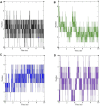Polyphenols and extracts from Zingiber roseum (Roxb.) Roscoe leaf mitigate pain, inflammation and pyrexia by inhibiting cyclooxygenase-2: an in vivo and in silico studies
- PMID: 38420193
- PMCID: PMC10900100
- DOI: 10.3389/fphar.2024.1344123
Polyphenols and extracts from Zingiber roseum (Roxb.) Roscoe leaf mitigate pain, inflammation and pyrexia by inhibiting cyclooxygenase-2: an in vivo and in silico studies
Abstract
Zingiber roseum (Roxb.) Roscoe, a perennial herb from the Zingiberaceae family, has a long history of traditional use in the treatment of several ailments including pain, inflammation, fever, cough, arthritis, skin diseases, and liver infections. This study sought to confirm the efficacy of Zingiber roseum (Roxb.) Roscoe leaves methanol extract (ZrlME) as reported in traditional usage by evaluating its analgesic, anti-inflammatory, and antipyretic capabilities. In addition, in silico molecular docking of the metabolites identified in ZrlME was studied to verify the experimental outcomes. ZrlME demonstrated strong dose-dependent analgesic efficacy against all analgesic tests. ZrlME (400 mg/kg) showed higher anti-inflammatory activity than the standard in the carrageenan-induced paw edema test model. A significant reduction of rectal temperature (3.97°F↓) was also recorded at the same dose of ZrLME after 24 h of treatment. Seven polyphenolic metabolites were identified and quantified by HPLC-DAD analysis, including 3, 4- dihydroxy benzoic acid, (-) epicatechin, rutin hydrate, p-coumaric acid, trans-ferulic acid, rosmarinic acid, and myricetin. Strong binding affinities (ranges from -5.8 to -8.5 Kcal/mol) between the aforesaid polyphenols and cyclooxygenase-2 were discovered. Moreover, molecular dynamics simulations (MDS) demonstrated that these polyphenols exhibit significant COX-2 inhibitory activity due to their high stability in the COX-2 active site. In computational prediction, the polyphenols were also found to be nontoxic, and a variety of biological activities, such as antioxidant, analgesic, anti-inflammatory, antipyretic, and hepatoprotective, were observed. The results of this study revealed that ZrlME possesses notable analgesic, anti-inflammatory, and antipyretic properties.
Keywords: Zingiber roseum; analgesic activity; anti-inflammatory activity; antipyretic activity; polyphenols.
Copyright © 2024 Ahmed, Ahmed, Rahman, Hossain, Han, Geng, Daula and Mamun.
Conflict of interest statement
The authors declare that the research was conducted in the absence of any commercial or financial relationships that could be construed as a potential conflict of interest.
Figures









Similar articles
-
Integrating in vivo and in silico approaches to investigate the potential of Zingiber roseum rhizome extract against pyrexia, inflammation and pain.Saudi J Biol Sci. 2023 Apr;30(4):103624. doi: 10.1016/j.sjbs.2023.103624. Epub 2023 Mar 9. Saudi J Biol Sci. 2023. PMID: 36970254 Free PMC article.
-
Zingiber roseum Rosc. rhizome: A rich source of hepatoprotective polyphenols.Biomed Pharmacother. 2021 Jul;139:111673. doi: 10.1016/j.biopha.2021.111673. Epub 2021 May 6. Biomed Pharmacother. 2021. PMID: 33965729
-
Anti-inflammatory, analgesic, antitussive and antipyretic activities of polyphenol-enriched fraction from Nymphaea candida.J Ethnopharmacol. 2024 Apr 24;324:117789. doi: 10.1016/j.jep.2024.117789. Epub 2024 Jan 23. J Ethnopharmacol. 2024. PMID: 38266950
-
Pharmacological investigation of analgesic and antipyretic activities of methanol extract of the whole part of Aeginetia indica.J Ethnopharmacol. 2021 May 10;271:113915. doi: 10.1016/j.jep.2021.113915. Epub 2021 Feb 7. J Ethnopharmacol. 2021. PMID: 33567308
-
A Comprehensive Review on Phytochemistry, Ethnopharmacology, and Pharmacological Properties of Zingiber roseum (Roxb.) Roscoe.Curr Top Med Chem. 2023;23(11):931-942. doi: 10.2174/1568026623666230126143635. Curr Top Med Chem. 2023. PMID: 36703584 Review.
Cited by
-
Harnessing the Power of Polyphenols: A New Frontier in Disease Prevention and Therapy.Pharmaceuticals (Basel). 2024 May 27;17(6):692. doi: 10.3390/ph17060692. Pharmaceuticals (Basel). 2024. PMID: 38931359 Free PMC article. Review.
References
-
- Al-Amin M., Siddiqui M. A., Ruma S. A., Eltayeb N. M., Sultana G., Salhimi S. M., et al. (2019). Antimicrobial activity of the crude extract, fractions and isolation of zerumbone from the rhizomes of Zingiber roseum. Marmara Pharm. J. 23 (3), 559–566. 10.12991/jrp.2019.163 - DOI
-
- Amanat M., Daula A. S. U., Singh R. J. P. R. (2023). Acute toxicity assessment of methanolic extract of Zingiber roseum (Roscoe.) rhizome in swiss albino mice. Pharmacol. Res. - Mod. Chin. Med. 7, 100244. 10.1016/j.prmcm.2023.100244 - DOI
-
- Babu C. R. (1977). Herbaceous flora of dehra dun. New Delhi: Council of Scientific and Industrial Research.
-
- Benavente-García O., Castillo J., Marin F. R., Ortuño A., Del Río J. A. J. J., chemistry F. (1997). Uses and properties of citrus flavonoids. J. Agric. Food Chem. 45 (12), 4505–4515. 10.1021/jf970373s - DOI
LinkOut - more resources
Full Text Sources
Research Materials
Miscellaneous

